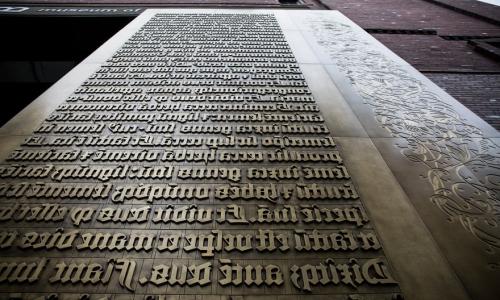The Gutenberg at the Museum of the Bible
Joel Baden (Professor of Hebrew Bible, Yale Divinity School)
In November 2017, the massive new Museum of the Bible in Washington, D.C. opened its doors. These were no ordinary doors: no aspect of the museum’s architecture is without symbolic meaning, and the very first thing that visitors encounter when they approach the building are the 40-foot tall, sixteen-ton bronze doors covered in a reproduction of the type from the first edition of the Gutenberg Bible.
Designed by artist Larry Kirkland, the bronze Gutenberg doors at Museum of the Bible are intended to closely mimic the metalwork of Gutenberg’s original type. Most notably, they contain vertically engraved lines between each letter or monogram, showing exactly how the type would have been set.
For most visitors, the text will be more evocative than it is legible: not only is it in Latin, of course, but it is reversed, appearing as it would have when typeset in the press rather than as it did on the page. Visitors may thus take rubbings of individual letters or words from the doors, thereby replicating the print process. (Somewhat confusingly, the doors also include marginal decoration, though only on the right-side door. Here the simulation of Gutenberg’s type bed becomes untenable, though it certainly makes for a more attractive entrance.)
For Museum of the Bible, the Gutenberg is more than just external decoration. The museum was founded by the Oklahoma City-based Green family, the owners of Hobby Lobby, who have dedicated their lives, and their vast financial resources, to disseminating the Bible across the country and throughout the world. For these missionaries at heart, Gutenberg’s printing press, which allowed for the wide distribution of a uniform biblical text, is among the msot important religious, not just technical, innovations of all time.
It is no surprise, then, that at the heart of the museum, in the very center of the fourth floor, dealing with the history of the Bible as a book, a visitor finds a full-sized replica of the Gutenberg press. Every so often, an actor depicting Gutenberg provides a live demonstration of the press, printing off a page of the Bible, and takes questions from visitors gathered around the exhibit.
This replica press has been a feature of Museum of the Bible since even before there was a permanent museum space. For years, the press and actor were a key element of the traveling exhibit, Passages, that toured the United States while the museum’s permanent site was being chosen and prepared. The idea for the exhibit was taken over almost entirely from other touring Bible exhibits, most notably one called Ink and Blood, whose replica press was manufactured by Rusty Maisel, the same person responsible for the one in Passages. The Gutenberg press, in other words, has been a staple of the Christian Bible exhibit scene for many years.
Museum of the Bible also, of course, owns and displays a few individual leaves, probably from the first edition of the Gutenberg Bible, as well as an intact copy of the fourth edition of 1462, produced by Fust and Schoeffer.
